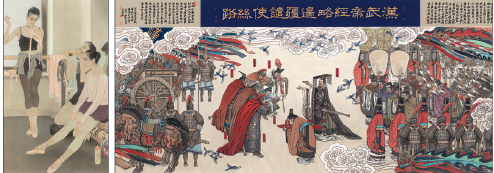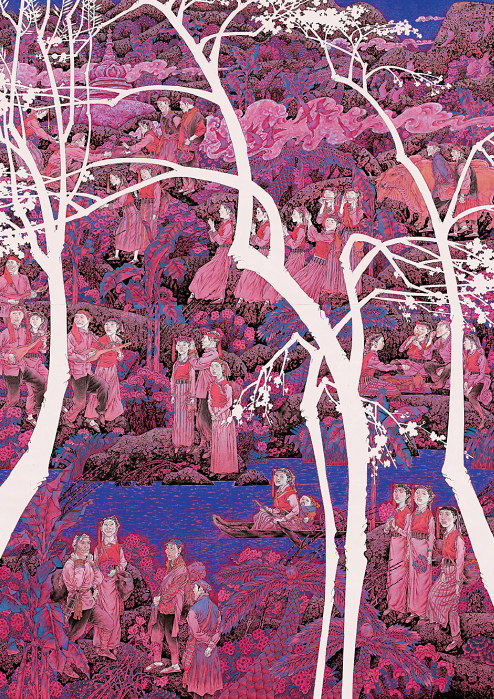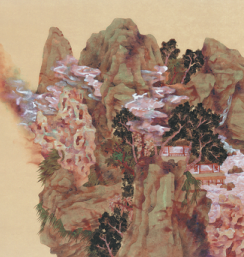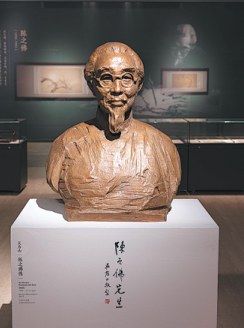A brush with history
Vibrant colors and themes reflected in classical artwork at gongbi exhibition, Lin Qi reports.

Classical ink paintings that are rendered using the long-standing gongbi technique have always been a favorite at art shows. This particular technique demands meticulous and precise brushwork, and its rich colors often enhance a feeling of elegance and being highly narrative.
The employment of fine gongbi technique can be found in some of the best-known artworks in Chinese history, such as Court Ladies Wearing Floral Headwear, attributed to the 8th-century painter Zhou Fang, and Along the River During the Qingming Festival by Zhang Zeduan of the Song Dynasty (960-1279).
Modern masters like Qi Baishi are also noted for utilizing the technique to depict, in vivid detail, small insects and feathered animals.
Unlike their ancient predecessors, who took delight in hailing naturalism and a pursuit of solitary living, gongbi painters today focus on a realistic approach to portray people's mentality.
This development was given full expression at the 11th National Exhibition of Chinese Hue Art, which wrapped up on Sunday at the National Art Museum of China in Beijing. Launched by the China Hue Art Association, the exhibition showed the evolution of gongbi art over the past five years and was also a celebration of the centennial of the Communist Party of China this year.
More than 400 paintings were on display, bringing together the works of well-established artists whose achievements in other styles of painting have breathed new life into the tradition of gongbi painting.
The show also served as a launch pad for up-and-coming artists, whose intensive exposure to global movements in art has inspired them to refresh the creation of ink art.
He Jiaying, a noted figure painter, ushers the fine style of "court lady" painting into the context of modern life.
His work A Break During Dance, painted on silk, retains the elegance and tranquility of shinyu tu, a classical style gongbi painting depicting women from a well-to-do background. Whereas, at the same time, its depiction of three ballerinas is reminiscent of the work of French impressionist Edgar Degas.
He says that, for years, the National Exhibition of Chinese Hue Art "has given a boost to the creation of quality gongbi paintings and a scene even more dynamic and diverse", but he also finds some works "rather wanting in technique and taste".
His style has been a subject of study and imitation among gongbi painters, but he says that one should dig deeper into the heart of Chinese painting if aspiring to be distinctive.
"Firmly, I am rooted in the soil of Chinese culture, and meanwhile, I reach out to absorb the nutrition of foreign art," He says.
According to He, the artist should truly understand the core values of Chinese art and build a confidence in it before they can further push the front line of traditional gongbi paintings.
The exhibition also set off a surge of appreciation for gongbi art at the National Art Museum. The museum organized another two shows-Exhibition of Fine Brushwork Paintings Collected by NAMOC, which also wrapped up on Sunday, and Standing Out From Three Centuries, a collaboration with Nanjing Museum to show works by Chen Zhifo, a modern master of gongbi paintings, which runs through May 9.
"The history (of art and culture)marches from one peak to another," says Wu Weishan, director of the National Art Museum. "These exhibitions show the evolution of gongbi art from the Song Dynasty until today, as well as its unique charm as an independent form of art.
"These works are traces of history and also reflections of the spirit of the time," he says.




Today's Top News
- Wang to meet foreign ministers of Cambodia, Thailand in Yunnan
- China's top legislature concludes standing committee session
- Thailand and Cambodia agree to temporary ceasefire
- NPC's 4th annual session slated for early March
- Civilizational links for a fairer world
- Manufacturing in China spurs global growth






























